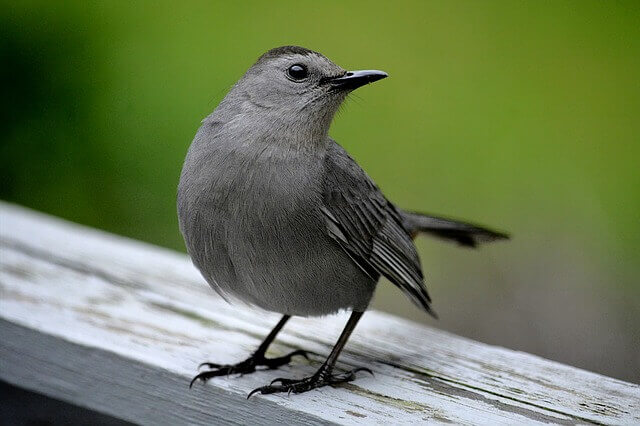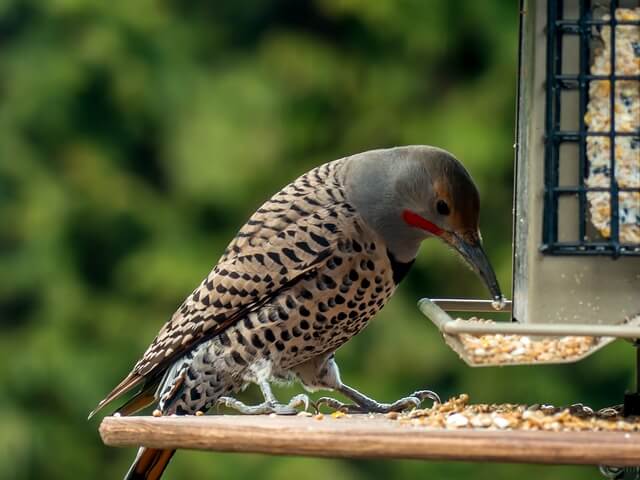Explore Pennsylvania’s diverse birding scenes! From mountains to rivers, the Keystone State is a haven for a variety of bird species. In this guide, we’ll highlight the 52 most common birds you can find in Pennsylvania, whether you’re a seasoned birder or just starting out.
Table of Contents
- 1 Most Common Birds in Pennsylvania
- 1.1 Northern Cardinal
- 1.2 Blue Jay
- 1.3 American Robin
- 1.4 Mourning Dove
- 1.5 American Crow
- 1.6 Song Sparrow
- 1.7 American Goldfinch
- 1.8 Downy Woodpecker
- 1.9 Tufted Titmouse
- 1.10 Red-bellied Woodpecker
- 1.11 European Starling
- 1.12 White-breasted Nuthatch
- 1.13 Carolina Wren
- 1.14 House Finch
- 1.15 Red-winged Blackbird
- 1.16 Dark-eyed Junco
- 1.17 Gray Catbird
- 1.18 House Sparrow
- 1.19 White-throated Sparrow
- 1.20 Northern Flicker
- 2 Frequently Asked Questions
- 2.1 What is the most common bird in Pennsylvania?
- 2.2 What is the native bird of Pennsylvania?
- 2.3 Are blue jays rare in Pennsylvania?
- 2.4 What is the largest bird in Pennsylvania?
- 2.5 Are there wild parrots in Pennsylvania?
- 2.6 How many species of birds are in PA?
- 2.7 Are there ravens in Pennsylvania?
- 2.8 Are there wild peacocks in Pennsylvania?
- 2.9 Are there golden eagles in PA?
- 2.10 Are there ospreys in Pennsylvania?
- 2.11 Are there vultures in Pennsylvania?
- 3 Author
Most Common Birds in Pennsylvania
Northern Cardinal
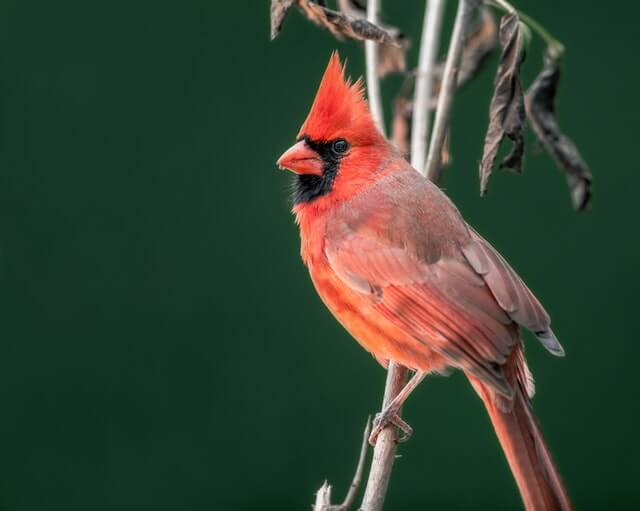
The Northern Cardinal’s range spans from southern Canada to northern Mexico. The habitat of the cardinal is in woodlands, gardens, and forests. Their diet consists of insects, seeds, berries, and fruits. The Northern cardinal is a beautiful bird that is easily recognizable by its red plumage. The male bird is especially vibrant, with a deep red coloration.
The female bird is more subdued in color, with a lighter red or even a brownish hue. Both sexes have black beaks and feet. The Northern cardinal is an important part of the ecosystem because it helps to control the population of insects. The cardinal also spreads seeds from the fruits and berries it eats, which helps to propagate plants and maintain healthy forest habitats.
- Frequency: 40.82% (Statistic by: eBird)
- Color: Mostly red with a black mask on the face, short pink bill
- Habitat: woodlands, gardens, parks, backyards, and wetlands
- Range: USA, Canada, Mexico
- Size: 8.2 – 9.3″ inches
- Weight: 33 – 65 grams
- Diet: Fruits, berries, and insects (grasshoppers, beetles, snails, cicadas)
- Family: Cardinalidae
- Genus: Cardinalis
- Maps: Range Map – Sightings Map
- Sounds: Calls and Songs
Related:
Blue Jay
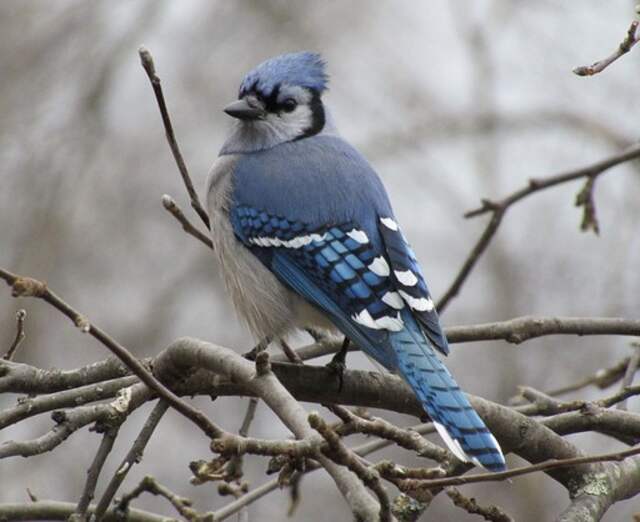
The Blue Jay can be seen throughout most of North America. They are easily recognizable by their blue plumage and white chest. Blue Jays are known to be very noisy birds, often making loud chattering sounds. Blue Jays have a large range and can be found in woodlands, forests, and even urban areas. They tend to group together in pairs or small groups.
During the breeding season, Blue Jays will build their nests in trees. Blue Jays primarily eat insects and acorns. However, they will also eat fruits, nuts, and other small animals. In the winter months when food is scarce, Blue Jays have been known to cache food for later use.
- Frequency: 38.15%
- Color: Blue crest on the head, wings, back, and tail, and has a white face and belly
- Habitat: Deciduous and mixed forests, mixed woodlands, backyards, parks
- Range: Southern Canada, Eastern and Central United States, Florida and Texas
- Size: 8 – 12″ inches
- Weight: 70 – 100 grams
- Diet: Nuts, seeds, caterpillars, grasshoppers, and beetles
- Family: Corvidae
- Genus: Cyanocitta
- Maps: Range Map – Sightings Map
- Sounds: Calls and Songs
Related:
- How to Attract Blue Jays to your Yard?
- 15 Best Bird Feeders For Blue Jays (Tried & Tested 2022)
- What do Blue Jay Eat – All The Facts
American Robin
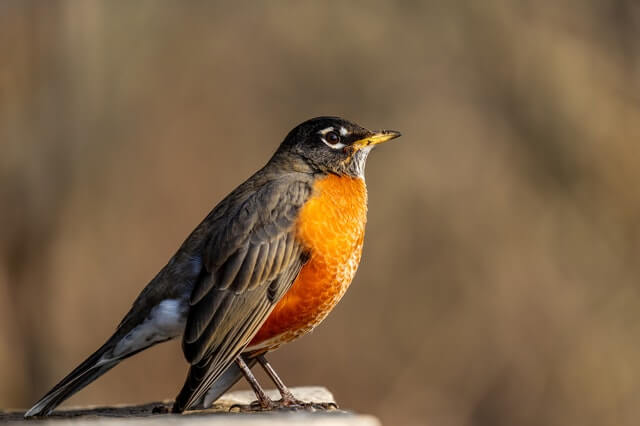
The American Robin (Turdus migratorius) is a common bird found throughout North America. This bird has a large range, stretching from Alaska to Newfoundland in the north, and from California to Florida in the south. These birds are most commonly found in woodlands or open areas near forests.
However, they’re also found in many suburban and urban areas. Robins typically eat insects, such as beetles, caterpillars, and grasshoppers, as well as worms, snails, and other small animals. They also eat fruits and berries.
- Frequency: 44.55%
- Color: Mostly brown on the back with an orange colored breast
- Habitat: Wooded areas, backyards, parks, fields
- Range: USA, Canada, Mexico
- Size: 12 – 16″ inches
- Weight: 72 – 95 grams
- Diet: Fruits, berries and insects (earthworms, beetles, caterpillars)
- Family: Turdidae
- Genus: Turdus
- Maps: Range Map – Sightings Map
- Sounds: Calls and Songs
Related:
Mourning Dove

The Mourning Dove (Zenaida macroura) is a member of the bird family Columbidae. The species is also called the Carolina pigeon and the rain dove. It ranges from southern Canada to northern Venezuela, and is the official state bird of Georgia, South Dakota, and Wisconsin. The mourning dove is a plump bird with a long tail and pointed wings.
It is about 31 cm (12 in) long with a wingspan of 51 cm (20 in). The adult has pale gray-brown upperparts, whitish underparts, and a black collar around its neck. Its head is small and has a black mark on its forehead. The mourning dove’s diet consists mainly of seeds, but it also eats insects.
- Frequency: 38.25%
- Color: Light gray-brown and lighter and pinkish below. The wings have black spots.
- Habitat: Open habitats, urban areas, farms, prairie, grassland, wooded area
- Range: USA, Canada, Mexico, Central America, Greater Antilles
- Size: 12″ inches length
- Weight: 112 – 170 grams
- Diet: Rapeseed, corn, millet, safflower, sunflower seeds, pokeberry, sesame, and wheat.
- Family: Columbidae
- Genus: Zenaida
- Maps: Range Map – Sightings Map
- Sounds: Calls and Songs
Related:
- Best Bird Feeder For Doves (Reviewed & Tested for 2022)
- Facts About Mourning Doves – 10 Things You Need To Know!
American Crow
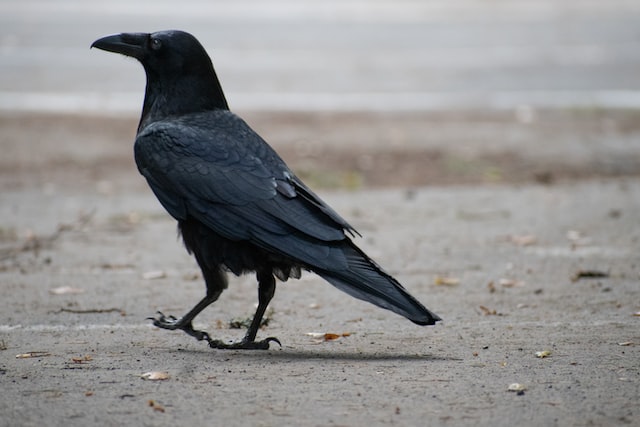
The American crow (Corvus brachyrhynchos) is a large passerine bird native to North America. Measuring around 40 cm (16 in) in length, it is an all-blackbird with a thick bill and distinctive caw. It ranges from Southern Canada to Northern Mexico, and can be found in most of the contiguous United States. The American crow generally inhabits open areas near forests, but can also be found in more urban settings, such as parks and golf courses.
It is a highly adaptable bird and will readily take advantage of any available food source, including human refuse. The diet of the American crow consists primarily of invertebrates such as insects and earthworms, but it will also eat small vertebrates, fruits, and nuts.
- Frequency: 30.47%
- Color: Black
- Habitat: Open country, farms, parks, woodlands, towns, cities
- Range: Canada, USA, Mexico
- Size: 16 – 21″ inches
- Weight: 315 -620 grams
- Diet: invertebrates, carrion, seeds, eggs fish, grains, mice, frogs, and other small animals.
- Family: Corvidae
- Genus: Corvis
- Maps: Range Map – Sightings Map
- Sounds: Calls and Songs
Related: How To Attract Crows To Your Backyard: Expert Tips!
Song Sparrow
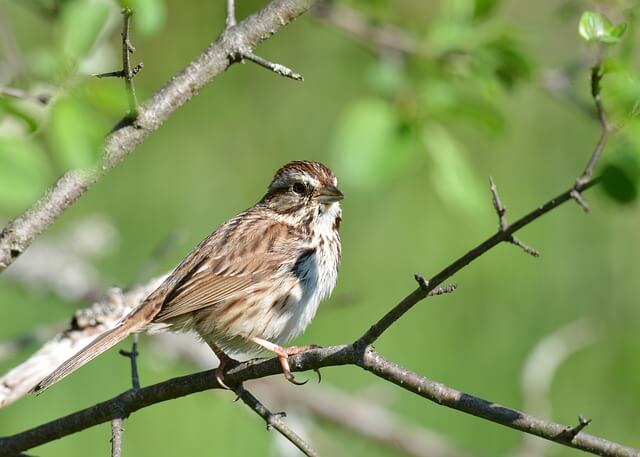
The Song Sparrow is a North American sparrow. The breeding habitat is brushy areas across Canada, the western United States, and Alaska. They nest on the ground, usually in a well-hidden location. The Song Sparrow has a large range. It can be found in forests, gardens, fields, and marshes.
It is a common bird that is often seen near human habitation. The diet consists mainly of insects and plant seeds. In summer, they eat mainly insects and their larvae. In winter, they switch to eating mostly seeds. Their favorite seeds come from grasses, weeds, and sedges.
- Frequency: 35.44%
- Color: Gray head, white cheek, a black bib, rufous neck.
- Habitat: Urban centers, farms, backyards, edges, yards, and parks.
- Range: Europe, Mediterranean, Asia, Australasia, Africa, and the Americas.
- Size: 5.5 – 7.0″ inches
- Weight: 25 – 40 grams
- Diet: Grains, seeds, and insects
- Family: Passeridea
- Genus: Passer
- Maps: Range Map – Sightings Map
- Sounds: Calls and Songs
Related: How to Attract Sparrows to your Backyard
American Goldfinch
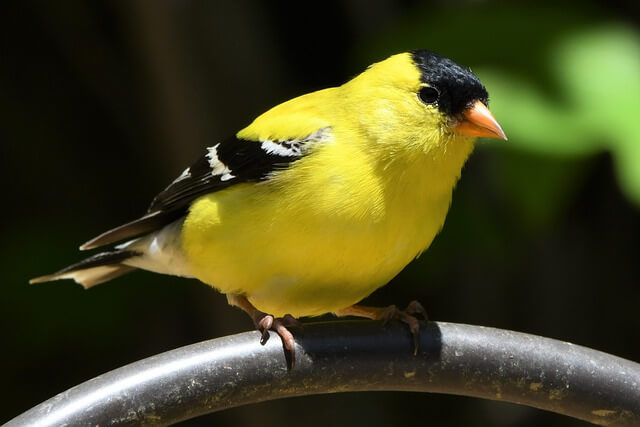
The American Goldfinch are small, sprightly songbirds with cheerful calls. This bird is a common sight at backyard bird feeders and in open fields across North America. These birds are well adapted to life in the wild and have many interesting behaviors. Goldfinches usually live in forests or woodlands, but they can also be found in open areas such as meadows and fields.
They often build their nests in trees or shrubs, but they will also use man-made structures such as houses and fences. Goldfinches are social birds and often form large flocks. The diet of goldfinches consists mainly of seeds from plants such as thistles, sunflowers, and dandelions. They will also eat insects, especially during the nesting season, when their young need protein-rich food to grow.
- Frequency: 38.20%
- Color: Face, neck, and underside are yellow, black wings with white bars.
- Habitat: Deciduous forests and thickets, roadside, grasslands, backyards, meadows.
- Range: Canada, USA and Mexico
- Size: 4.3 – 5.5″ inches length
- Weight: 12 -18 grams
- Diet: Grass, dandelions, chickweed, sunflowers and ragweed, thistle, red alder, birch, spruce seeds.
- Family: Carduelinae
- Genus: Spinus
- Maps: Range Map – Sightings Map
- Sounds: Calls and Songs
Related: American Goldfinch Interesting Facts
Downy Woodpecker
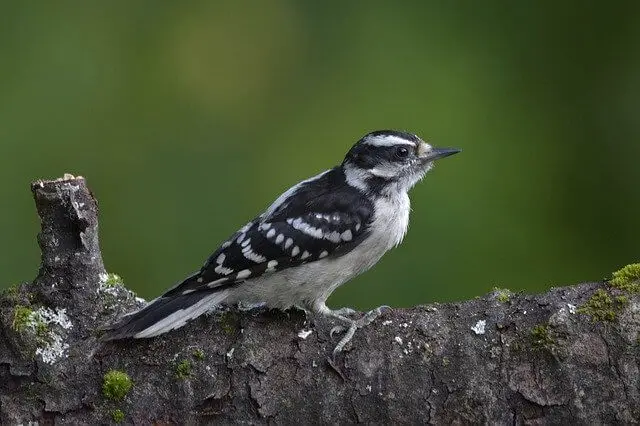
The Downy Woodpecker is a small woodpecker found throughout most of North America. These birds are common in both forests and urban areas and are known for their loud drumming on trees. The Downy Woodpecker has a black back and wings, with white stripes running down the sides of its body. The male also has a red patch on the back of its head. These birds are relatively small, measuring only about 6-7 inches in length.
The Downy Woodpecker’s range extends across most of North America, from Alaska and Canada all the way down to Mexico. These birds can be found in a variety of habitats, including both forested and urban areas. The diet of the Downy Woodpecker consists mainly of insects, although they will also eat fruits, nuts, and other small animals.
- Frequency: 34.69%
- Color: Black with a white throat, belly, and back. White spots on wings.
- Habitat: Deciduous forests and thickets, roadside, grasslands, backyards, parks.
- Range: Canada, USA, and Mexico
- Size: 5.5 – 7.1″ inches in length
- Weight: 20 – 33 grams
- Diet: Mostly insects and beetles and ants, also gall wasps, caterpillars.
- Family: Picadae
- Genus: Dryobates
- Maps: Range Map –
Sightings Map - Sounds: Calls and Songs
Related: How to Attract Downy Woodpeckers to Your Yard? (Easy!)
Tufted Titmouse
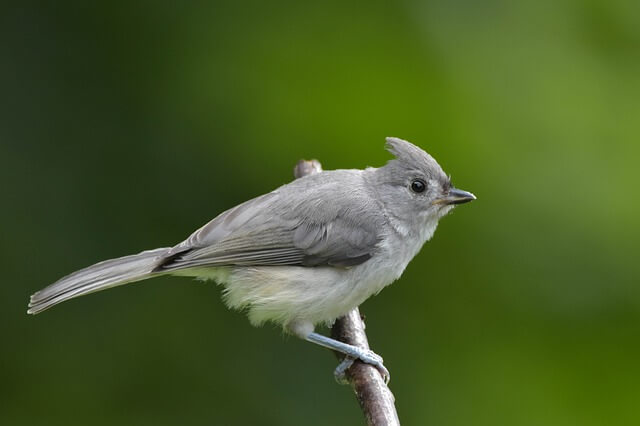
The Tufted Titmouse (Baeolophus bicolor) is a small songbird found in North America. The Tufted Titmouse is found in the eastern United States from Maine to Florida and west to Texas. This bird is gray with white underparts and a black cap. The male and female look similar. The Tufted Titmouse is about 5-6 inches long. The bird has a long tail and stout bill.
This bird is also found in parts of Canada. The Tufted Titmouse prefers woodlands, but can also be found in gardens and parks. The Tufted Titmouse eats insects, spiders, berries, and nuts. This bird will often cache food for later use. The Tufted Titmouse is an important part of the ecosystem as it helps to control insect populations.
- Frequency: 22.33%
- Color: Gray upperparts, white front, a tufted gray crest on the head.
- Habitat: Deciduous forests, river basin, backyards, swamps.
- Range: Canada, USA, and Mexico
- Size: 5.5 – 6.4″ inches
- Weight: 18 – 26 grams
- Diet: Nuts, insects, berries, seeds small fruit, and snails.
- Family: Paridae
- Genus: Baeolophus
- Maps: Range Map – Sightings Map
- Sounds: Calls and Songs
Related: How to Attract Tufted Titmouse to my Yard
Red-bellied Woodpecker
The Red-bellied Woodpecker breeds mostly in the southern part of the United States, ranging east of the Mississippi and north of the Canadian border. It was first found in southern Pennsylvania and Maryland, but now it is widespread in several locations in the northeast and Midwest.
The diet of the red-bellied woodpecker includes small insects, worms, carrion, and suet. During the winter, they enjoy a sheltered location in backyards where they roost during the winter and then move to an open area nearby in springtime to feed.
- Frequency: 26.59%
- Color: Gray on body and face and underparts. Black and white pattern on wings, back, and tail.
- Habitat: Forests, backyards
- Range: Southern Canada, Eastern United States, Florida.
- Size: 9 – 10.6″ inches long
- Weight: 56 -91 grams
- Diet: Insects, tree frogs, eggs of small birds, oozing sap, and small fish.
- Family: Picidae
- Genus: Melanerpes
- Maps: Range Map – Sightings Map
- Sounds: Calls and Songs
Related: How to Attract Red-bellied Woodpeckers to your Yard?
European Starling

The European Starling is a small to medium-sized bird that is found throughout Europe, Asia and North Africa. The bird is also found in the United States, where it was introduced in the late 1800s. The European Starling has a dark plumage with white spots and a long, forked tail.
This bird typically measures between 15 and 20 cm in length and weighs between 60 and 100 grams. The European Starling is an omnivorous bird, feeding on insects, fruits and berries. The bird typically nests in trees or shrubs, but can also nest in man-made structures such as buildings or nest boxes.
- Frequency: 21.18%
- Color: Black with glossy iridescence plumage.
- Habitat: Forests, woodlands, backyards, edges, yards, and parks.
- Range: North America, Europe, Africa, India, Middle East, China.
- Size: 7 – 9″ inches long
- Weight: 60 – 100 grams
- Diet: Insects (ants, beetles, invertebrates), fruits, seeds, berries
- Family: Sturnidae
- Genus: Sturnus
- Maps: Range Map – Sightings Map
- Sounds: Calls and Songs
Related: How To Attract European Starlings To Your Yard Fast?
White-breasted Nuthatch
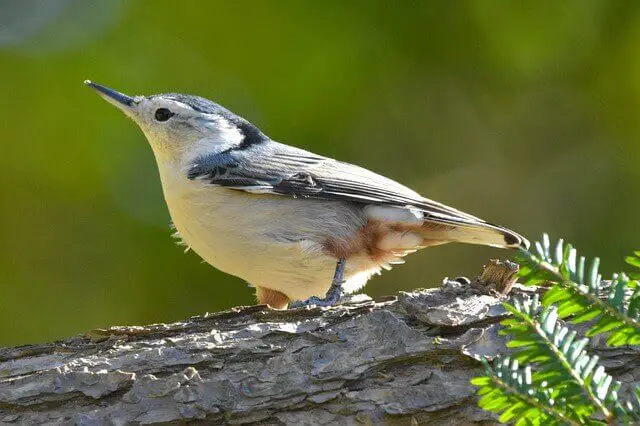
The White-breasted Nuthatch is a small songbird with a large head, short tail, and stout bill. It is grayish-brown above and has a white breast with black streaks. The nape and sides of the head are chestnut-brown. The White-breasted Nuthatch ranges from Alaska and Canada to the Appalachian Mountains in the east.
It is found in both deciduous and coniferous forests. The White-breasted Nuthatch is a common bird of residential areas, parks, and woods. It often nests in tree cavities or nest boxes. The diet of the White-breasted Nuthatch consists mostly of insects and their larvae, but it also eats seeds, nuts, and berries.
- Frequency: 32.97%
- Color: Has a white face, flanks, and chest. It has a black cap on its head a bluish-gray upper and a brown belly
- Habitat: Deciduous forests, conifers, roadside, rivers, backyards, parks
- Range: Southern Canada, USA
- Size: 5.9″ inches
- Weight: 20 grams
- Diet: Acorn nuts, hickory nuts, ants, caterpillars, scale insects, pine weevils
- Family: Sittidae
- Genus: Sitta
- Maps: Range Map – Sightings Map
- Sounds: Calls and Songs
Related: How to Attract Nuthatches to your Backyard
Carolina Wren
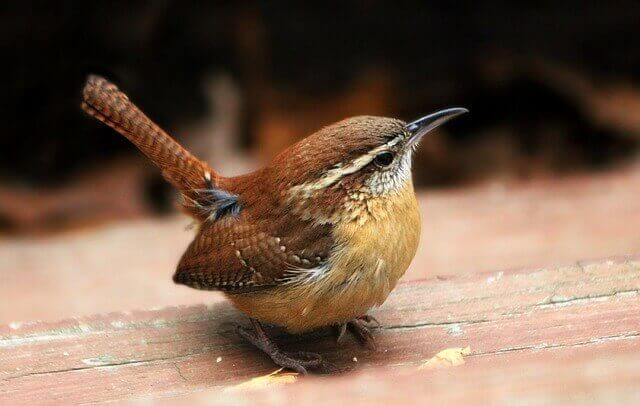
The Carolina Wren (Thryothorus ludovicianus) is a small songbird of the wren family. It is the only member of its genus native to the eastern United States. The Carolina wren ranges from southeastern Canada to central Florida and west to eastern Texas. The Carolina wren is a non-migratory bird which prefers habitats with dense understory cover, such as forests, gardens, and parks.
The bird’s diet consists mainly of insects, although it will also eat berries and other fruit. The Carolina wren is a relatively common bird with a stable population. However, due to habitat loss and fragmentation, the bird is considered threatened in some parts of its range.
- Frequency: 26.23%
- Color: Black cap and throat with white cheeks. Light gray wings, back, and tail.
- Habitat: Deciduous forests, suburbs, parks, backyards
- Range: USA ( Texas, Florida, New Jersey, and Kansas)
- Size: 4.5 – 5.1″ inches long
- Weight: 9 – 12 grams
- Diet: Insects, berries, seeds
- Family: Paridae
- Genus: Poecile
- Maps: Range Map – Sightings Map
- Sounds: Calls and Songs
Related: How to Attract Wrens to your Backyard? (Expert’s Guide)
House Finch
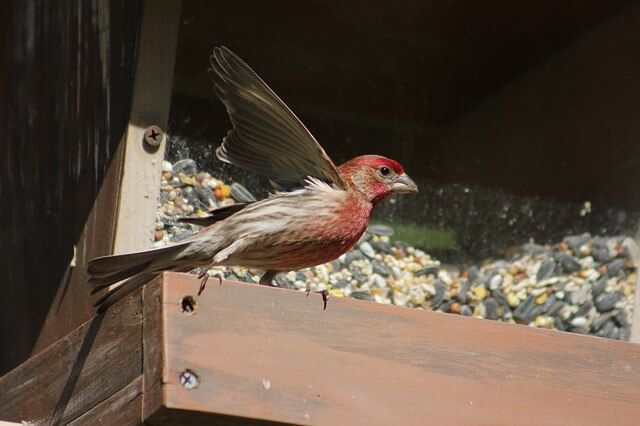
The House Finch is a small songbird native to North America. It is a member of the Finch family, which includes other birds such as the purple finch and the Cassin’s finch. The house finch is one of the most common birds in North America, and its range extends from Alaska to Newfoundland and southward into Mexico. The natural habitat of the house finch is open woodlands, but it has adapted well to human activity and can be found in urban and suburban areas.
It nests in trees or on ledges, and often builds its nest using materials such as twigs, paper, cloth, or feathers. The diet of the house finch consists primarily of seeds and berries, but it will also eat insects. The house finch is a popular bird among birdwatchers due to its vocalizations and bright plumage.
- Frequency: 21.14%
- Color: Reddish face and upper breast, brown streaks on back, belly, and tail.
- Habitat: Urban and suburban areas, backyards, edges, yards, and parks.
- Range: Canada, USA, Mexico
- Size: 5 – 6″ inches
- Weight: 16 – 27 grams
- Diet: Aphids, grains, seeds, berries, nettle, dandelion, sunflower.
- Family: Fringillidae
- Genus: Haemorhous
- Maps: Range Map – Sightings Map
- Sounds: Calls and Songs
Related:
Red-winged Blackbird
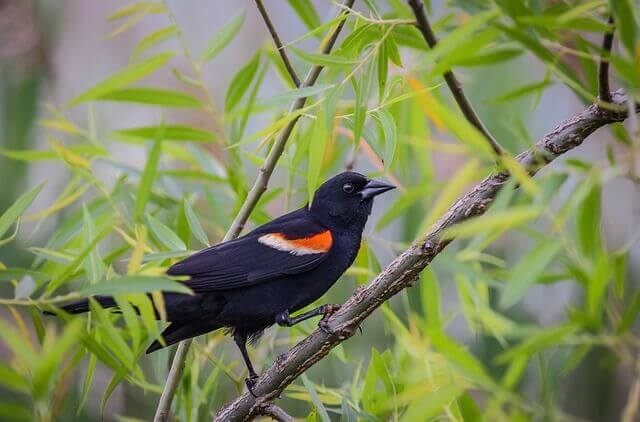
The Red-winged Blackbird (Agelaius phoeniceus) is a species of true blackbird in the family Icteridae. The male has distinctive red and yellow shoulder patches and a black head, back, tail and wings. Females are similar to males, but have a brownish body and lack the shoulder patches. Both sexes have a yellow eyes.
The Red-winged Blackbird is found in North America, where it breeds from Alaska and Canada to the Gulf of Mexico and Florida. The breeding habitat is marshes with some trees or shrubs. Non-breeding birds can be found in open habitats such as fields, meadows or prairies. These birds are omnivorous and eat a variety of insects, spiders, snails, berries and seeds.
- Frequency: 25.63%
- Color: All black with red patches on shoulder and a yellow wing bar
- Habitat: Deciduous forests, conifers, roadside, rivers, backyards, parks
- Range: North America, Central America
- Size: 6.7 – 7.1″ inches length
- Weight: 41.5 – 65 grams
- Diet: Seeds and insects (butterflies, dragonflies, moths, frogs, worms, spider, snails, carrion, flies.)
- Family: Icteridae
- Genus: Agelaius
- Maps: Range Map – Sightings Map
- Sounds: Calls and Songs
Dark-eyed Junco
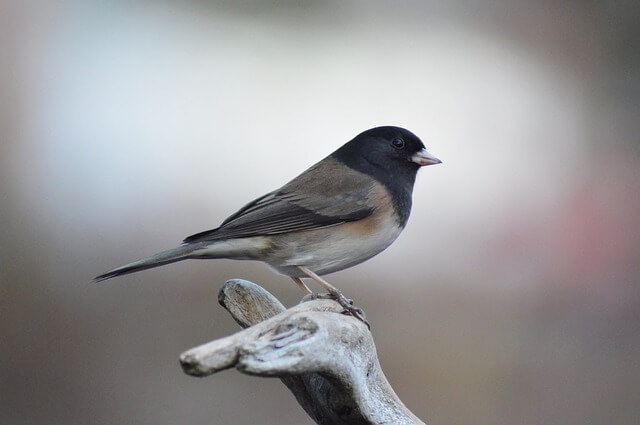
The Dark-eyed Junco is a North American sparrow that can be found in many different habitats throughout the continent. Though they are most commonly seen in forests, they can also be found in open woodlands, along streams, and in mountain meadows. These birds are very adaptable, and their diet consists of mostly seeds and insects. The Dark-eyed Junco is a small bird with a gray body and white belly.
The sides of its head and throat are chestnut brown, and it has a black bill. Its tail is long and pointed, and its legs are pinkish-brown. The male bird has a darker head than the female, but both sexes have dark brown eyes. These birds breed from Alaska to Newfoundland, south to California, Arizona, New Mexico, Texas, the Great Plains, and eastern Canada.
- Frequency: 20.08%
- Color: Gray head, neck, breast, gray/brown backs and wings, white underside
- Habitat: Wooded areas, forest edges, roadsides, gardens, parks.
- Range: USA and Canada
- Size: 5.1 – 6.9″ inches
- Weight: 18 – 30 grams
- Diet: Seeds, insects, and arthropods
- Family: Passeriformes
- Genus: Junco
- Maps: Range Map – Sightings Map
- Sounds: Calls and Songs
Related: Fun Facts About Dark-eyed Juncos
Gray Catbird
The Gray Catbird is a member of the Mimidae family, which includes mockingbirds and thrashers. It ranges from southern Canada to northern South America, and is found in a variety of habitats including forests, swamps, and urban areas. The diet of the Gray Catbird consists primarily of insects, but it will also eat fruits and berries.
The Gray Catbird is a shy bird that is often heard before it is seen. Its call is a loud, raspy meow that sounds similar to a cat. The bird gets its name from this call. The male and female look alike and are grayish-brown with black streaks on their back and wings. They have a long tail that they often hold upright. The birds are about 8-10 inches in length with a wingspan of about 13 inches.
- Frequency: 15.08%
- Color: Mainly Gray with black on tail and head, white accents on the body
- Habitat: Woodlands, marshes, meadows
- Range: East of the Canadian Rockies, Canada, USA, Mexico, Central America, and the Caribbean
- Size: 8 – 9.5″ inches
- Weight: 23 – 57 grams
- Diet: Fruits, berries, earthworms, beetles, bugs, ants caterpillars, grasshoppers, moths.
- Family: Mimidae
- Genus: Dumatella
- Maps: Range Map – Sightings Map
- Sounds: Calls and Songs
House Sparrow
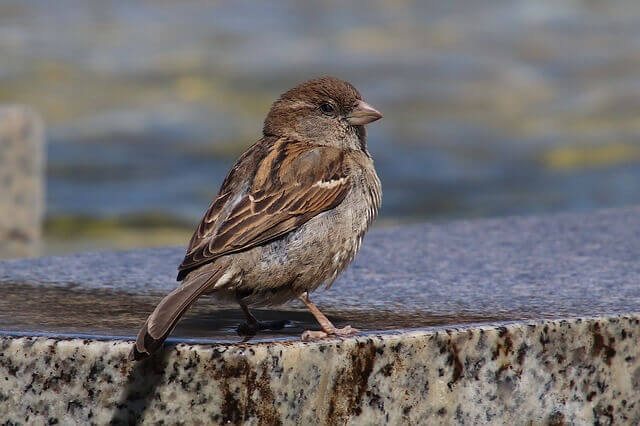
The house sparrow is a small bird with a short neck and sturdy build. The male is gray on top with buff-colored streaks, and the female is brown on top with a splash of gray. The ground is white in the male and the female. The bill is black in winter, and yellow in summer in the male and the female. The legs and feet are reddish-pink. The house sparrow is found in Europe, Asia, and Africa.
In North America, it is found in Alaska and across Canada to Nova Scotia. It is also found in the United States from Maine to Montana, south to Texas, and along the West Coast to California. The house sparrow prefers open habitats such as farmland, parks, and gardens. It nests in trees, bushes, or holes in buildings. The diet of the house sparrow consists of seeds, insects, and spiders.
- Frequency: 27.95%
- Color: Gray head marking, a reddish-brown back, and gray underparts.
- Habitat: Urban centers, suburban areas, backyards, edges, yards, and parks.
- Range: North America, Central America, South America, Africa, Australia, New Zealand.
- Size: 5.5 – 7.1″ inches in length
- Weight: 25 – 39 grams
- Diet: Insects, beetles, caterpillars, aphids,, grasshoppers, crustaceans, earthworms, vertebrates.
- Family: Passeridea
- Genus: Passer
- Maps: Range Map – Sightings Map
- Sounds: Calls and Songs
Related: How to Attract Sparrows to your Backyard
White-throated Sparrow
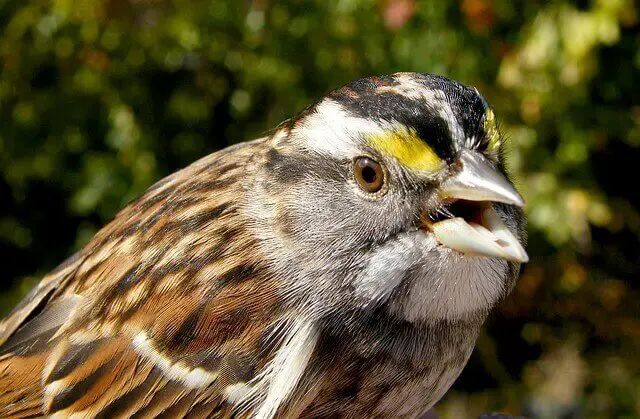
The White-throated Sparrow (Zonotrichia albicollis) is a small sparrow with a white throat and yellow markings on its head. It has a wide range, stretching from Alaska and Canada to the eastern United States. It is a migratory bird, spending the winters in southern states such as Texas and Florida.
The White-throated Sparrow prefers open habitats such as forests, fields and gardens. It nests on the ground, often near bushes or trees. The female builds the nest using grasses, twigs and leaves. The diet of the White-throated Sparrow consists mainly of insects and seeds.
- Frequency: 13.89%
- Color: Brown and gray head pattern. Black-and-white-striped head, white throat, and yellow near the eye.
- Habitat: Deciduous forests and thickets, roadside, grasslands, backyards.
- Range: Eastern North America, Atlantic Canada
- Size: 5.9″ – 7.5″ inches long
- Weight: 22 – 32 grams
- Diet: Seeds, insects, and berries
- Family: Passerellidae
- Genus: Zonotrichia
- Maps: Range Map – Sightings Map
- Sounds: Calls and Songs
Northern Flicker
The Northern Flicker is a beautiful bird that is found in North America. The range of the Northern Flicker extends from Alaska and Canada to the southern United States. This bird is also found in Hawaii. The Northern Flicker prefers open woodlands and forests for its habitat. This bird also commonly nests in trees cavities.
The diet of the Northern Flicker consists mostly of ants and other insects, which it captures with its long tongue. They will occasionally feed on fruits, berries, and seeds. The Northern Flicker is an important part of the ecosystem as it helps to control insect populations.
- Frequency: 19.66%
- Color: Light brown with black bars across back, chest, wings, belly
- Habitat: Forests, woodlands, backyards, edges, yards, and parks
- Range: North America, Central America, Cuba, Cayman Islands
- Size: 10 – 14″ inches
- Weight: 85 – 165 grams
- Diet: Insects (ants, beetles, invertebrates), fruits, seeds, berries
- Family: Picadae
- Genus: Colaptes
- Maps: Range Map – Sightings Map
- Sounds: Calls and Songs
Related: How to Attract Northern Flickers to your Backyard? (Easy)
The backyard birds below, have a frequency of less than 19%
- Common Grackle 18.73%
- Black-capped Chickadee 18.37%
- Carolina Chickadee 17.57%
- Eastern Bluebird 15.98%
- Chipping Sparrow 15.27%
- Eastern Towhee 13.84%
- Hairy Woodpecker 12.10%
- Tree Swallow 12.07%
- Brown-headed Cowbird 11.42%
- Northern Mockingbird 11.40%
- Eastern Phoebe 11.33%
- Common Yellowthroat 10.98%
- Red-eyed Vireo 10.78%
- House Wren 10.55%
- Barn Swallow 9.94%
- Cedar Waxwing 9.80%
- Belted Kingfisher 8.42%
- Rock Pigeon 8.36%
- Pileated Woodpecker 8.20%
- Wood Thrush 8.15%
- Chimney Swift 7.84%
- Field Sparrow 7.51%
- Baltimore Oriole 7.37%
- Indigo Bunting 6.86%
- Yellow Warbler 6.77%
- Ruby-throated Hummingbird 6.57%
- Eastern Wood-Pewee 6.29%
- Yellow-rumped Warbler 6.28%
- Blue-gray Gnatcatcher 6.05%
- Ovenbird 6.03%
- Fish Crow 5.83%
- Scarlet Tanager 5.50%
Frequently Asked Questions
What is the most common bird in Pennsylvania?
The Northern Cardinal is the most common bird in Pennsylvania according to eBird. The frequency of occurrence for the Northern Cardinal is 51.50%. The Northern Cardinal is a gorgeous redbird with a black mask and a thick reddish bill. They are commonly found in woodlands, gardens, and shrublands.
What is the native bird of Pennsylvania?
Pennsylvania’s official State Bird is the Ruffed Grouse. The Ruffed Grouse is a medium-sized bird that is about 16 to 20 inches in length. The males have a ruff of feathers around their necks and are usually slightly larger than the females. The Ruffed Grouse can be found in forests throughout Pennsylvania. The Ruffed Grouse is a popular game bird and is hunted for sport in many parts of the state.
Are blue jays rare in Pennsylvania?
No, Blue Jays are not rare in Pennsylvania. In fact, they are quite common. According to eBird, the Blue Jay is the 3rd most common bird in the state, with a frequency of occurrence of 45.41%. So if you’re ever in Pennsylvania and you see a blue bird, there’s a good chance it’s a Blue Jay!
What is the largest bird in Pennsylvania?
The Sandhill Crane is the largest bird in Pennsylvania. Standing nearly four feet tall, with a wingspan of seven feet, these powerful birds are an impressive sight. They are also the loudest bird in Pennsylvania, with a call that can be heard up to two and a half miles away. Originally found only in the western United States, the Sandhill Crane has slowly been making its way east. In Pennsylvania, they are most commonly found in the northeastern part of the state.
Are there wild parrots in Pennsylvania?
There are four species of wild parrots in Pennsylvania: the Monk Parakeet, Rose-ringed Parakeet, Green-rumped Parrotlet and the Orange-fronted Parakeet. All of these parrots are very rare, with the Monk Parakeet being the most common.
The Monk Parakeet is the only species of parrot that is known to breed in Eastern Pennsylvania. These parrots are native to South America, but they have been introduced to Pennsylvania through the pet trade.
How many species of birds are in PA?
There are 481 species of birds in Pennsylvania. This number includes both native and non-native species. The highest concentration of bird species is found in the southeastern part of the state, where there are more than 300 species.
Are there ravens in Pennsylvania?
The Common Raven is the only species of raven found in Pennsylvania. Ravens are large, black birds that are known for their intelligence and scavenging abilities. Ravens are often seen near human settlements, as they are attracted to areas where there is a lot of food available.
Are there wild peacocks in Pennsylvania?
Yes, there are wild peacocks in Pennsylvania, but they are very rare. According to eBird, a frequency of occurrence of only 0.0003%. The Indian Peafowl is the only species of peacock that can be seen in the wild in Pennsylvania.
Are there golden eagles in PA?
There are golden eagles in Pennsylvania, but they are very rare. According to eBird, they have a frequency of occurrence of only 0.2115%. That said, there have been confirmed sightings of golden eagles in the state. So while they are not commonly seen in Pennsylvania, it is possible to spot a golden eagle if you’re lucky.
Are there ospreys in Pennsylvania?
Ospreys are a fairly rare bird in Pennsylvania, with a frequency of occurrence of only 4 percent according to eBird. They are most often found near large bodies of water such as lakes and rivers. Ospreys typically mate for life and build their nests in trees or on cliffs.
Are there vultures in Pennsylvania?
Yes, there are vultures in Pennsylvania. The two species are the Turkey Vulture and the Black Vulture. The Turkey Vulture is the more common of the two, and can be found throughout the state. The Black Vulture is less common, but can still be found in some areas of Pennsylvania.



